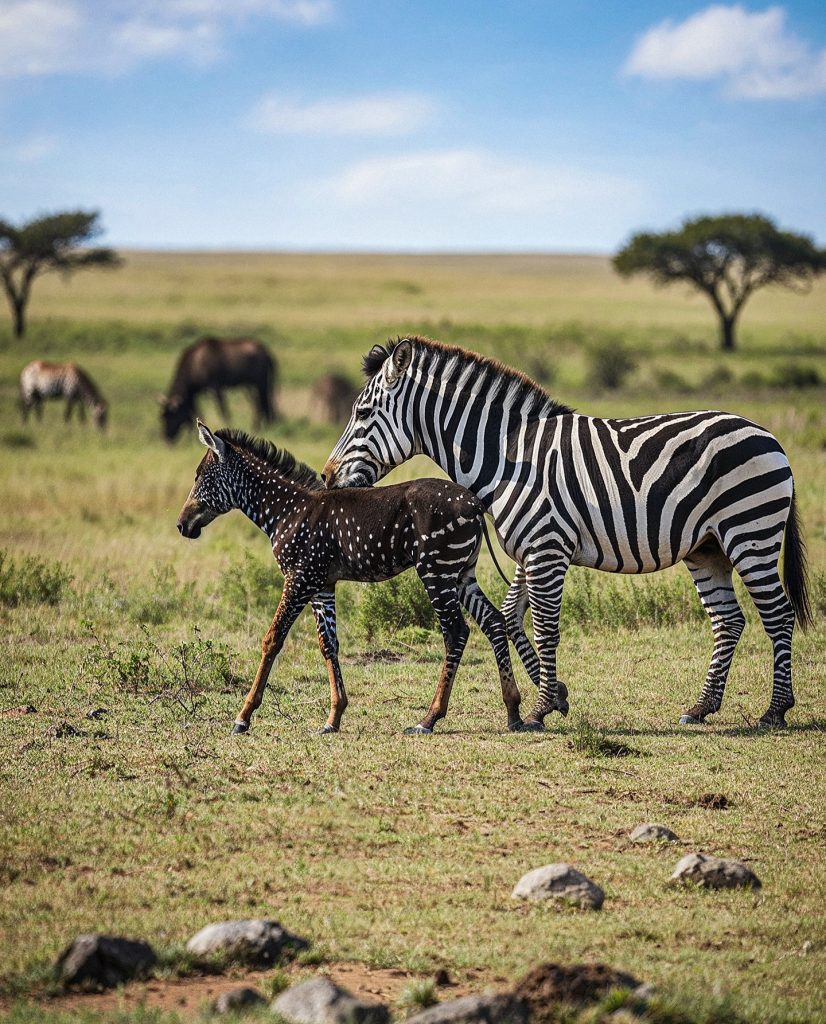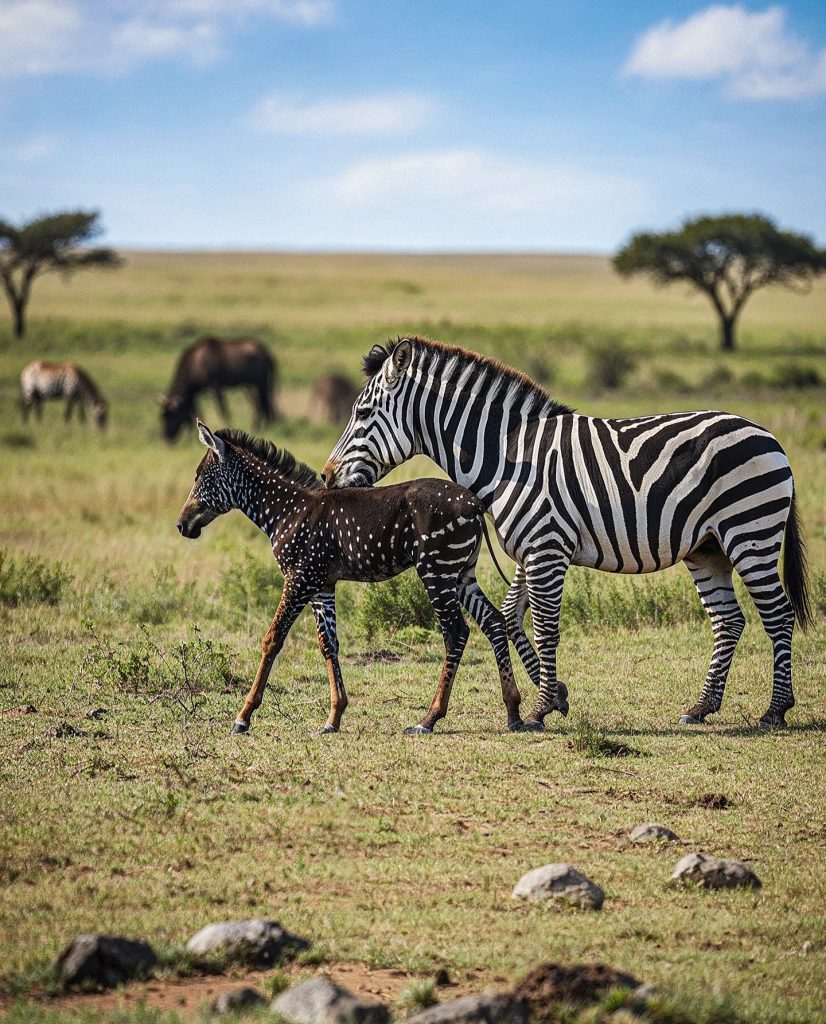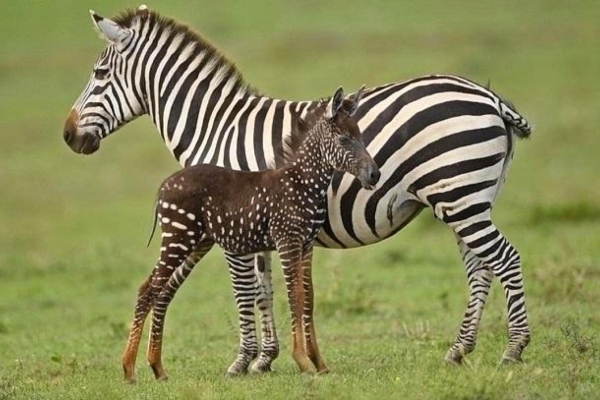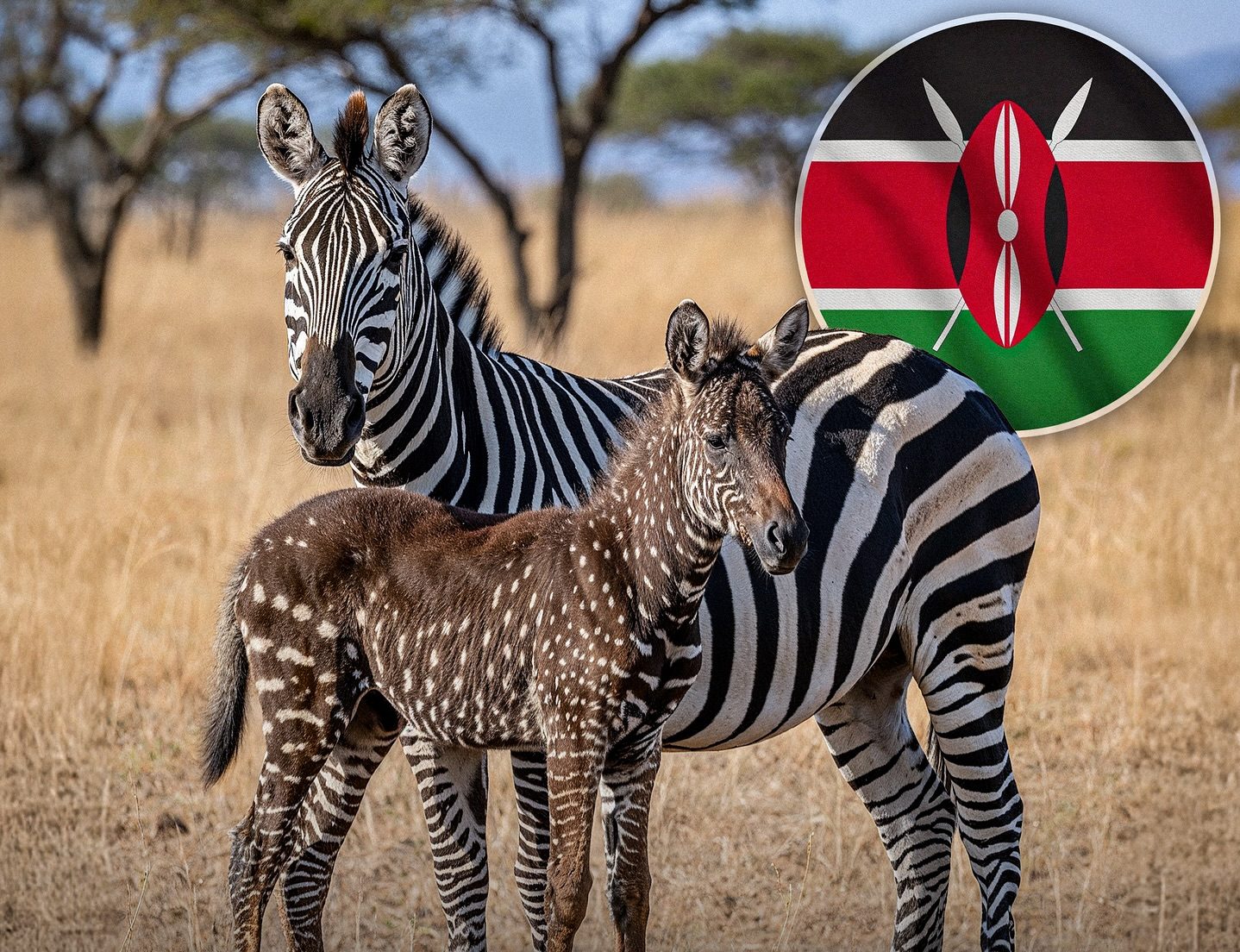A Once-in-a-Lifetime Discovery: Rare Polka-Dot Baby Zebra Spotted in Kenya’s Masai Mara, Redefining the Beauty of Nature
In the golden plains of Kenya’s Masai Mara, a young zebra foal stepped into the world and instantly captured global attention. Unlike the hundreds of thousands of zebras that roam Africa with their iconic black-and-white stripes, this foal stood out for an extraordinary reason: its body was covered in polka dots. For those lucky enough to be nearby, it felt like witnessing a living miracle, a one-in-a-million sight that proved once again how unpredictable and wondrous nature can be.
Wildlife photographers who spotted the foal quickly realized they were looking at something rare. The unusual coat pattern wasn’t just a random quirk but a result of pseudomelanism, a rare genetic variation that changes the typical stripe formation of a zebra. Instead of tidy vertical lines, the foal’s body showed a beautiful scattering of white dots against a dark chocolate-colored background.

To understand why this little foal is so special, it’s important to look at the numbers. Across Africa, there are roughly half a million plains zebras, the most common species of the zebra family. Yet, despite those numbers, sightings of pseudomelanistic zebras are so rare that they can be counted on one hand. Most zebras are born with the familiar stripe pattern, which not only looks beautiful but also serves important purposes in survival, such as camouflage in tall grass and even confusing biting flies.
For this foal, its polka-dot pattern might work differently. Researchers point out that rare coats like this sometimes make survival tougher because the animal stands out more to predators. Yet, at the same time, it gives conservationists and the world a chance to witness nature’s creativity in action. The foal becomes not just another zebra in the herd, but a symbol of resilience and uniqueness.
The unusual pattern is tied to a pigment disorder that disrupts the normal development of stripes in zebras. Instead of the pigment cells arranging themselves in neat vertical bands, they scatter, creating dots or irregular shapes. This condition doesn’t harm the zebra’s health directly — it’s more of an aesthetic difference. Still, biologists stress that every rare genetic variation provides new insights into how species adapt and evolve.

In zebras, stripe formation has long been a mystery. Some scientists believe the patterns evolved as a defense mechanism against predators, while others argue that they play a role in thermoregulation or even social interaction within herds. The appearance of a polka-dot zebra challenges these theories and adds another layer of complexity to understanding these iconic animals.
The fact that this rare foal was spotted in Kenya is meaningful in itself. Kenya is home to some of the most famous zebra populations, especially in the Masai Mara, where wildebeest and zebras form part of the Great Migration — one of the largest and most spectacular wildlife movements on Earth. Kenya is also home to most of the world’s remaining Grevy’s zebra, the rarest and largest of the zebra species. With only a few thousand Grevy’s zebras left, each foal born in the wild represents hope for the survival of a species under pressure from habitat loss and human encroachment. While the polka-dot foal is a plains zebra, not a Grevy’s, its birth serves as a reminder of the fragile beauty that exists in these ecosystems and the importance of protecting every acre of grassland.
Photographs of the foal spread quickly across social media, sparking reactions of awe and wonder. People described it as “magical,” “unbelievable,” and even “the most stylish zebra in Africa.” For many, it was a reminder that the natural world still holds surprises, even in an era when humans often feel they’ve seen it all. The polka-dot foal’s story also resonates beyond science. It represents the beauty of difference, the value of standing out, and the importance of cherishing life in all its forms. While many zebras look alike, this foal reminds us that individuality exists in the animal kingdom too.

Of course, the foal’s journey is just beginning. Life in the wild is never easy, and zebras face constant threats from predators like lions and hyenas. For a foal with such a unique coat, blending in with the herd might be more difficult, which raises concerns about its long-term survival. Yet zebras are social animals, and the foal’s acceptance by its mother and herd increases its chances of growing strong and thriving.
For conservationists, this rare zebra highlights why continued protection of habitats like the Masai Mara is so essential. With climate change, expanding farmland, and poaching threatening wildlife across Africa, every new birth feels like a small victory. The spotted zebra foal, rare as it is, adds urgency and inspiration to efforts to safeguard Kenya’s incredible biodiversity.
When people see a story about a polka-dot zebra, it’s easy to dismiss it as just another viral image. But in reality, it’s so much more. This foal carries lessons about science, conservation, and even the way we see ourselves. It shows us that rarity in nature is not just about survival but about celebrating the unexpected. It reminds us that even among half a million zebras, one can break the mold and capture the imagination of the entire world.
The next time you think you’ve seen all that nature has to offer, remember this little foal in Kenya. Against the backdrop of the golden savanna, dotted with acacia trees and filled with the sounds of wildlife, one zebra dared to be different. And in doing so, it reminded us that nature will always find a way to surprise us.

